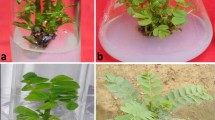Abstract
A highly efficient protocol for in vitro regeneration of an indigenous, endangered medicinal plant Celastrus paniculatus was achieved using nodal explants. Murashige and Skoog (MS) basal medium supplemented with 0.5 mg/L 6-benzylaminopurine (BAP) and 0.1 mg/L naphthaleneacetic acid (NAA) showed maximum percentage of shoot multiplication (83.4%) with 8.2 shoots/explants. Maximum rooting of 73.3% with 4.8 roots/shoot was achieved on half-strength MS media supplemented with 0.5 mg/L indole-3-acetic acid (IAA) and the percentage of survival was 91% after acclimatization. Random amplified polymorphic DNA (RAPD) and inter simple sequence repeat (ISSR) marker study confirmed genetic stability for in vitro raised explants by showing 100% monomorphism. High multiplication rate associated with genetic stability ensure the efficacy of the present in vitro clonal propagation protocol of this important medicinal plant species.
Similar content being viewed by others
References
Bantawa P., Saha-Roy O., Kumar S., Ghosh R. & Mondal K.T. 2011. In vitro regeneration of an endangered medicinal plant Picrorhiz scrophulariiflora. Biol. Plant. 55: 169–172.
Chandrika M. & Rai V.R. 2009. Genetic fidelity in micropropagated plantlets of Ochreinauclea missionis an endemic, threatened and medicinal tree using ISSR markers. Afr. J. Biotechnol. 8: 2933–2938.
De Silva M.A.N. & Senarath W.T.P.S.K. 2009. Development of a successful protocol for in vitro mass propagation of Celastrus paniculatus Willd. — a valuable medcinal plant. Tropical Agricult. Res. 21: 21–29.
Doyle J.J. & Doyle J.L. 1990. A rapid DNA isolation procedure for small quantities of fresh leaf tissue. Phytochem. Bull. 19: 11–15.
Eshraghi P., Zarghami R. & Ofoghi H. 2005. Genetic stability of micropropagated plantlets in Date Palm. J. Sci. 16: 311–315.
Gopi C. & Nataraja, S.Y. Ponmurugan P. 2006. In vitro multiplication of Ocimum gratissimum L. through direct regeneration. Afr. J. Biotechnol. 5: 723–726.
Harter H.L. 1960. Critical values for Duncan’s multiple range test. Biometric. 16: 671–685.
Kaeppler S.M., Kaeppler H.F. & Rhee Y. 2000. Epigenetic aspects of somaclonal variation in plants. Plant Mol. Biol. 43: 179–188.
Lal D. & Singh N. 2010. Mass multiplication of Celastrus paniculatus Wild: An important medicinal plant under in vitro conditions via nodal segments. Int. J. Biodiv. Conserv. 2: 140–145.
Larkins P. & Scowcroft W.R. 1981. Somaclonal variation, a novel source of variability from cell cultures for plant improvement. Theor. Appl. Genet. 60: 197–214.
Martins M., Sarmento D. & Oliveira M.M. 2004. Genetic stability of micropropagated almond plantlets, as assessed by RAPD and ISSR markers. Plant Cell Rep. 23: 492–496.
Mohanty S., Panda M.K., Sahoo S. & Nayak S. 2011. Micropropagation of Zingiber rubens and assessment of genetic stability through RAPD and ISSR markers. Biol. Plant. 55: 16–20.
Murashige T. & Skoog F.A. 1962. Revised medium for rapid growth and bioassays with tobacco tissue culture. Physiol. Plant. 15: 473–497.
Murthy S.R., Kondamudi R. & Vijayalakshmi V. 2010. Micropropagation of an endangered medicinal plant Ceropegia spiralis L. J. Agri. Technol. 6: 179–191.
Premvaranon P., Vearasilp S., Thanapornpoong S., Karladee D. & Gorinstein S. 2011. In vitro studies to produce double haploid in Indica hybrid rice. Biologia 66: 1074–1081.
Rao M.S. & Purohit, S.D. 2006. In vitro shoot bud differentiation and plantlet regeneration in Celastrus paniculatus Willd. Biol. Plant. 50: 501–506.
Rekha K., Bhan M.K., Balyan S.S. & Dhar A.K. 2005. Cultivation prospects of endangered species Celastrus paniculatus Willd. Nat. Prod. Rad. 4: 483–486.
Rout G.R., Mahato A. & Senapati S.K. 2008. In vitro clonal propagation of Nyctanthes arbor-tristis. Biol. Plant. 52: 521–524.
Sharada M., Ashok A. & Kaul M.K. 2003. Regeneration of plantlets via callus cultures in Celastrus paniculatus Willd. — A rare endangered medicinal plant. J. Biochem. Biotec. 12: 65–69.
Sharma P.C., Yelne M.B. & Dennis T.J. 2001. Database on Medicinal Plants used in Ayurveda. Central Council for Research in Ayurveda and Sidda. Janakpori, New Delhi, 636 pp.
Swarna J. & Ravindhran R. 2012. In vitro propagation and assessment of genetic integrity of Talinum triangulare (Jacq.) Wild: a valuable medicinal herb. Acta Physiol Plant. 10: 1007–1017
Tantikanjana T., Young W.H.J., Letham D.S., Grifith M., Hussain M. & Ljung K. 2001. Control of auxillary budproliferation and shoot architecture in Arabidopsis through Supershoot gene. Genes Dev. 15: 1577–1588.
Vendrame W.A., Kochert G. & Wetzstein H.Y. 1999. AFLP analysis of variation in pecan somatic embryos. Plant Cell Rep. 18: 853–857.
Walia N., Sinha S. & Babbar S.B. 2003. Micropropagation of Crataeva nurvala. Biol. Plant. 46: 181–185.
Williams J.G.K., Kubelik A.R., Liva K.J., Rafalski J.A. & Tingey S.V. 1990. DNA polymorphisms amplified by arbitrary primers are useful as genetic markers. Nucl. Acids Res. 18: 6531–6535.
Zeitkiewicz E., Rafalski A. & Labuda D. 1994. Genome finger printing by simple sequence repeat (SSR)-anchored PCR amplification. Genomics. 20: 176–183.
Author information
Authors and Affiliations
Corresponding author
Rights and permissions
About this article
Cite this article
Senapati, S.K., Aparajita, S. & Rout, G.R. Micropropagation and assessment of genetic stability in Celastrus paniculatus: An endangered medicinal plant. Biologia 68, 627–632 (2013). https://doi.org/10.2478/s11756-013-0187-1
Received:
Accepted:
Published:
Issue Date:
DOI: https://doi.org/10.2478/s11756-013-0187-1




